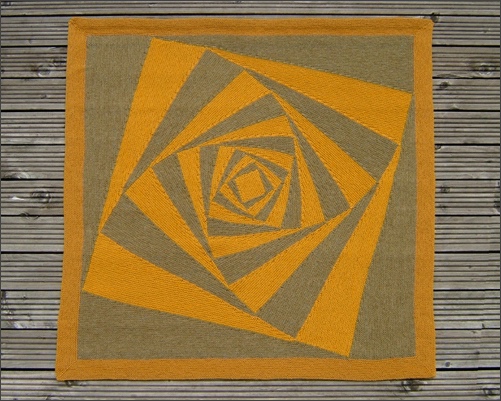




These are still triangles but this was the first break from 45, 90 and 135 degree angles. We have never bothered to calculate the size of the angles we used here. We knew that the angles would be the same throughout if the same process was repeated on every triangle. The triangles would be exactly the same shape, but bigger, on each round. Any number of rounds could be added until the afghan reached the desired size. The amount of turn was unimportant because the overall shape would always be a square.
When this design is drawn with good straight lines it is much easier to see why it is referred to as a curve. As with many of our other designs, some allowance has to be made for the nature of the knitting. Mathematically, lines have no thickness and points have no dimension. In knitting the lines and points can be very thick, depending on the yarn used.
There are echoes here of From Square to Eternity because the stitches for each new triangle are picked up from the previous shapes. There are also close links with the spirals of Swirl Without End.
Mathematically the design is called a Curve of Pursuit so this was the name we gave to the afghan. Later we wondered why we hadn’t called it Trivial Pursuit so this was the name we gave to the cushion version.
It is called a Curve of Pursuit because it represents four dogs chasing each other round a field. The dogs start from the corners of the field and chase each other’s tails. If they were to keep going they would eventually crash in the middle. The path created by each dog is called an equiangular spiral. The curves become more obvious as more points along the route are connected.
The curve is drawn from the outside to the centre. The afghan has to start at the centre and work outwards. For practical reasons it can not start at a point so starts with a square. Mathematically, this means the dogs must have stopped before they caught each other.
Curve of Pursuit was never one of our favourite designs but it became one of the most popular with other people. It was always obvious when a particular afghan had been mentioned somewhere on the internet as there would be a little flurry of orders which would die down in a few days. This one suddenly took off in a big way, in 2006, almost ten years after it was first published.
First, for some reason, we had a constant stream of enquiries from Norway. I believe this was the result of one lady initially singing our praises. It was strange because Paypal was still in its infancy and many of the buyers did not speak English so were not able to buy the pattern themselves. A lot of sales were made via friends who could deal with these complications. I have always thought that the Norwegians must be the most honest nation in the world. They went to great lengths to buy a pattern that they would probably need to have translated once they got it. Less honest people would have just passed on a translated copy to their friends. I now have a vision of every Norwegian snuggling down under a Curve of Pursuit for the long winter nights.
In the same year we got another sudden rush of enquiries from US. Some of these were
very vague and we had no idea what had prompted them. Then an email arrived with
a photo attached. This was another miracle of twenty-
It transpired that authors Ann Shayne and Kay Gardiner had sent us a signed copy when the book was first published. Unfortunately, even though it was correctly addressed, the book did not arrive when it should. We didn’t know anything about this so bought another copy. The original turned up months later, having crossed the Atlantic several times, and shaped like a banana because it had obviously got wet at some point on its travels. We kept the banana and gave away the other.
In 2009 we got an unexpected phone call asking if Curve of Pursuit could be included in one of the early editions of a new magazine called The Knitter. The editor loved the pattern which she had previously knitted herself. She described it as iconic. At first we refused. Our doubts revolved around the fact that we still thought we wrote instructions for mathematicians and they were not in the conventional format knitters would expect. Amongst other things, knitters might like more instructions about ‘short rows’.
The Knitter decided to take the opportunity to run an article on short rows alongside. I don’t know how many people made a CofP as a result of it being in The Knitter. It is always difficult to gauge the response outside of Ravelry.
